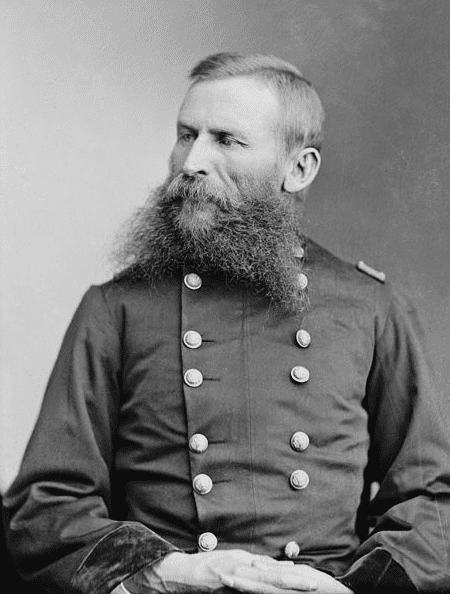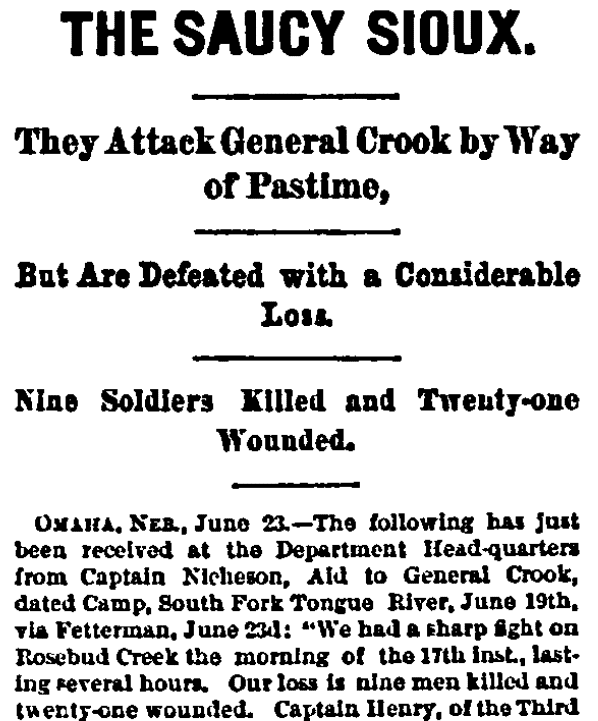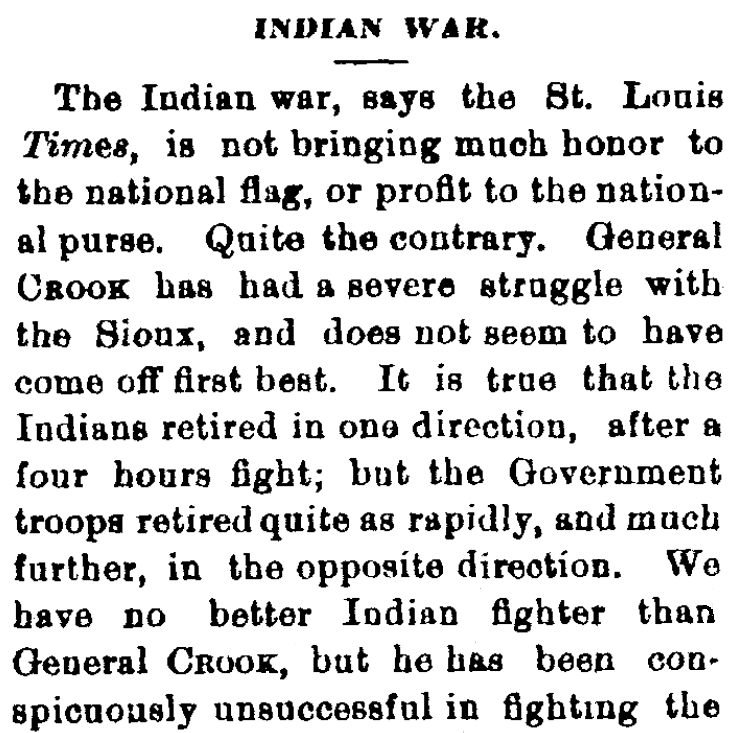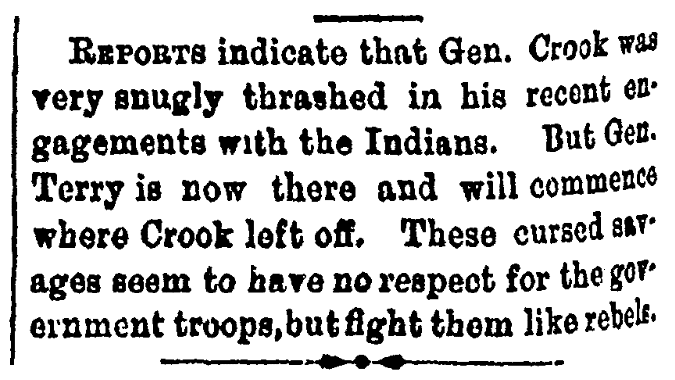In the summer of 1876, the United States was preparing to joyfully celebrate its centennial. The nation had been settled “from sea to shining sea,” and was a young country rich with resources and full of promise, recovering quickly from the ordeal of a dreadful civil war. However, this buoyant mood was dampened in late June and early July by newspaper reports of shocking defeats of U.S. troops by a large force of Arapaho, Cheyenne and Lakota Indians in Montana.
The annihilation on 25 June 1876 of nearly 300 men of the U.S. 7th Cavalry under the command of Lieutenant Colonel George Armstrong Custer at the Battle of the Little Bighorn was the biggest blow, but it was not the first that summer. Eight days prior, many of those same Native Americans had stopped another U.S. Army force bearing down to wipe out their large village, a force under the command of famous Indian fighter General George Crook.

That earlier Indian triumph was the Battle of the Rosebud on 17 June 1876 at Rosebud Creek in Montana Territory, and it showed the army it had a much larger fight on its hands than was anticipated.
The antecedent for the fighting of the summer of 1876 goes back to the Fort Laramie Treaty of 1868, in which the Lakota were promised that a huge swath of territory, known as the Great Sioux Reservation and including the sacred area of the Black Hills, would be theirs forever.
Despite this, the U.S. government sent Custer on an expedition into the Black Hills in 1874, and gold was discovered – leading to an inevitable gold rush of crazed miners who cared not a whit for honoring Indian treaties. Although the army at first tried to keep the miners out of the Black Hills, this soon proved impossible and the corrupt administration under President Grant decided to ignore the Fort Laramie Treaty.
All Arapaho, Cheyenne and Lakota Indians were ordered to abandon the Black Hills and relocate to some tightly restricted, barren reservations by 31 January 1876. After that date, any Native Americans not complying would be declared “hostile” and attacked. A large force of Indians, led by such renowned chiefs as Sitting Bull, Crazy Horse and Gall, disregarded the government’s command and gathered on the plains of Montana for the summer buffalo hunt. The army set out to destroy them.
A three-pronged attack was organized involving around 2,400 soldiers. From the west came a column led by Colonel John Gibbon. From the east came a column led by General Alfred Terry, including Custer and the 7th Cavalry. The third element of the attack was a column coming from the south, led by General George Crook. All three columns were supposed to converge on the Indian camp and wipe it out.
However, it did not happen that way, and the first setback for the army was the Battle of the Rosebud.

Crook had about 1,300 men under his command, including 261 Crow and Shoshone Indian scouts. The day before the battle, June 16, he had pushed his men hard on a forced, 35-mile march. The wagon train of supplies had been left behind, and each man was ordered to carry only four days’ rations and 100 rounds of ammunition. At 3:00 the morning of June 17, the exhausted men were roused from their blankets, and by 6:00 Crook’s column was on the move again.
What they did not know was that a large force of around 1,500 warriors, led by Crazy Horse, had left their village and rushed south to confront the advancing soldiers. The Indian attack began at 8:30 in the morning, and only the fierce resistance of Crook’s Crow and Shoshone scouts enabled his men to organize and prepare for the fight ahead.
What happened next astonished the soldiers. Prior fights with the Indians had always been quick affairs, but not this time. The Indians were determined, fought ferociously, and showed no signs of quitting. The battle raged for six hours before the Indians headed back to their village, convinced they had stopped the soldiers’ advance. And they had.
Their ammunition exhausted and the supply wagons far to their rear, Crook ordered his men to retreat. He reported losses of 32 killed and 21 wounded. Indian losses are estimated at around a dozen killed and 20 wounded. Crook went back to his camp on Goose Creek in Wyoming where his supplies were and simply settled down for seven weeks, ostensibly to wait for reinforcements. History will never know if his force could have arrived in time to save Custer from defeat at the Battle of the Little Big Horn eight days later.
The following four newspaper articles are about the Battle of the Rosebud. The first is a news report of the engagement, and the next three are editorial comments on the fight.

Here is a transcription of this article:
THE SAUCY SIOUX.
They Attack General Crook by Way of Pastime,
But Are Defeated with a Considerable Loss.
Nine Soldiers Killed and Twenty-one Wounded.
OMAHA, NEB., June 23. – The following has just been received at the Department Headquarters from Captain Nickerson, aide to General Crook, dated Camp, South Fork Tongue River, June 19th, via Fetterman, June 23d: “We had a sharp fight on Rosebud Creek the morning of the 17th inst., lasting several hours. Our loss is nine men killed and twenty-one wounded. Captain Henry, of the Third Cavalry, was the only officer hurt. He is severely wounded in the face. We won the fight and camped on the field. The Indians made the attack, and had a force they no doubt believed sufficient to whip this command.”
Crook’s command left camp the morning of the 16th instant, with four days’ rations. They struck across to Rosebud, a branch of the Yellowstone, in Montana, following down the creek. The next morning, about five miles down, the Snake and Crow scouts brought word from the front that the Sioux were in force in the hills, and by half past eight o’clock the command was in position, and an extensive fire inaugurated along the bluffs to the north of the creek, the enemy, who had begun the attack, and showing thereby their confidence in their ability to whip the command, retiring as the soldiers and allies advanced. The Sioux, all well mounted and well armed, and swarming in numbers at times, were prodigal in the use of ammunition. The fight lasted four hours, when the enemy retired out of sight at every point.
…One Snake scout was killed and three wounded, and four Crows were wounded. The dead bodies of the thirteen Sioux were found on the field, and it is certain that a number more were killed with the usual proportion wounded. Several Sioux ponies were killed, and General Crook’s horse shot under him. The fight occurred fifty miles from the wagon and pack trains, and owing to a want of rations, and that the wounded might be cared for, it was necessary to return thither.
The officers and soldiers all displayed marked gallantry, the nature of the ground making infantry advantageous. General Crook has ordered five companies to join him at once, the cavalry in the meantime continuing operations on the plains and in the hills. The Crows have returned to their homes. The Snakes will remain. The rich game country of the Big Horn affords an ample commissary department for the Sioux.

Here is a transcription of this article:
INDIAN WAR.
The Indian war, says the St. Louis Times, is not bringing much honor to the national flag, or profit to the national purse. Quite the contrary. General Crook has had a severe struggle with the Sioux, and does not seem to have come off first best. It is true that the Indians retired in one direction, after a four hours’ fight; but the Government troops retired quite as rapidly, and much further, in the opposite direction. We have no better Indian fighter than General Crook, but he has been conspicuously unsuccessful in fighting the Sioux. The cost and difficulty of such war need not be enlarged upon here. They are well understood at the West. This war has been forced upon us by the peace policy of the Administration, by its double dealing, and by its violation of treaties. If it is ever ended in our favor, it will be at an immense cost, all of which would have been avoided by an honest administration of Indian affairs under control of the War Department.

Here is a transcription of this article, which has a decidedly Southern slant:
Reports indicate that Gen. Crook was very snugly thrashed in his recent engagement with the Indians. But Gen. Terry is now there and will commence where Crook left off. These cursed savages seem to have no respect for the government troops, but fight them like rebels.

Here is a transcription of this article, which was written after news of the defeats of both Crook and Custer had been received:
THE INDIAN WAR.
The country will understand the character and extent of the Indian war which our government now has on its hands, much the better for the sad intelligence made public yesterday. The force of Indians now on the war path far exceeds in numbers any force that has been gathered together for many years, and they occupy a strong natural position far from the bases of supply for the troops moving against them. A few days ago an Indian force had the temerity to attack that famous fighter of Indians, Gen. Crook, and although repulsed, they proved so formidable that his column fell back to its base of supply. Another army, under Gen. Gibbon, was moving from another quarter to cooperate with Gen. Crook, the advance being under the command of Gen. Custer. With that bravery for which he has been distinguished, coupled with the recklessness that has interfered with his usefulness as a soldier, Gen. Custer rode into an Indian camp of probably three thousand Sioux warriors, at the head of three hundred men, and all were slaughtered. The remaining companies of his command were surrounded, but they kept the enemy at bay for a day and night, when the army of Gen. Gibbon came up and relieved them. The disaster will greatly delay contemplated movements, and prolong the war. The Indians have obtained many choice weapons, and the army has been weakened, where it most needed strength.
Note: An online collection of newspapers, such as GenealogyBank’s Historical Newspaper Archives, is not only a great way to learn about the lives of your ancestors – the old newspaper articles also help you understand American history and the times your ancestors lived in, and the news they talked about and read in their local papers. Did any of your ancestors fight in the Indian wars? Please share your stories with us in the comments section.
Explore over 330 years of newspapers and historical records in GenealogyBank. Discover your family story! Start a 7-Day Free Trial
Related Article:
